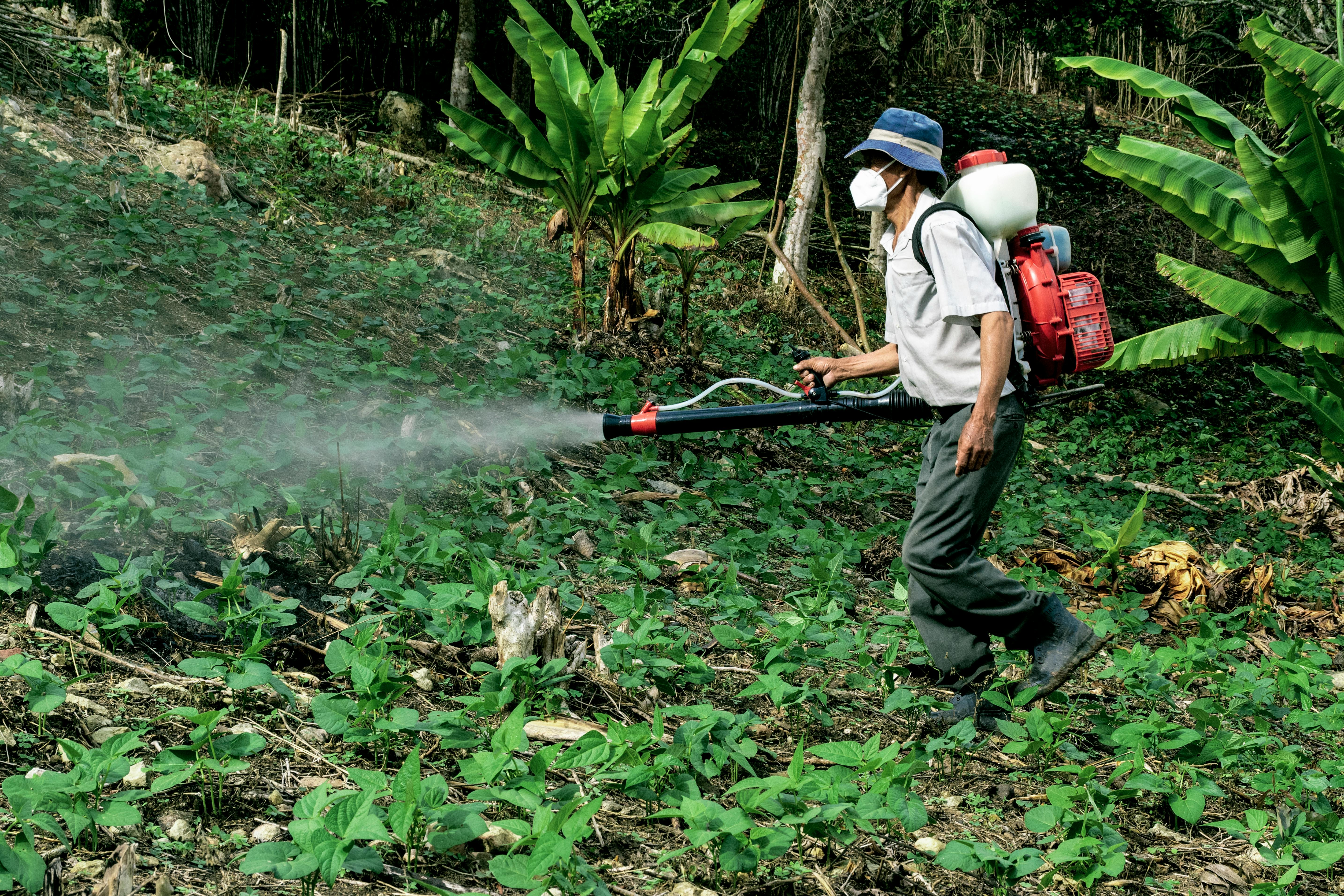Agricultural pesticide pressure in overseas France
Agri-STAMP
Agri-STAMP
Agricultural pesticide pressure in overseas FranceThe Agri-STAMP project is a research and development project aimed at improving the characterisation of agricultural pesticide pressure in the French Overseas Departments and Regions (DROMs), in support of
the Water Framework Directive and to assess the pressures on biodiversity. Co-funded by the Office Français de la Biodiversité (OFB) and CIRAD, it follows on from the PresAgriDom and GESSICa projects, carried out between 2015 and 2018 and 2021 and 2023 respectively.
The aim of the PresAgriDom project, co-financed by the Office national de l'eau et des milieux aquatiques (Onema) and CIRAD, was to develop a tool for calculating pesticide pressure using the BNV-d (Banque Nationale des Ventes distributeurs) and the RPG (registre parcellaire graphique). The aim was to produce pesticide and nitrogen indicators to assess pressures on water quality at the level of water bodies, as part of the European Water Framework Directive (WFD). The indicators were developed for Guadeloupe, Martinique and Réunion. The pesticide indicator was used for the 2019 Environmental Status Report (EDL 2019) and received generally positive feedback from users, such as the Water Offices and the Environment, Planning and Housing Departments (DEAL) of the various DROMs. Limitations and improvements have been identified, such as taking into account the runoff/drainage split, harmonising the pressure intensity scales and providing elements for validating the indicators. Over and above the inventory exercise, needs have emerged in terms of information sharing and forecasting. The local partners wanted to deepen their understanding of the proposed indicators in order to integrate them into their actions and evaluation systems. They also
want to be able to test solutions and assess the impact of new practices as part of a forward-looking approach.
The aim of the Feder Gessica project (https://www.gessica.org), in partnership with the University Hospital Centre (CHU) of Guadeloupe and the French National Institute for Health and Medical Research (Inserm), was to gain a better understanding of cancer risk factors in Guadeloupe, by studying the interaction between these factors and the pesticides used in agriculture. CIRAD had to provide spatio-temporal indicators relating to the use of active substances and the resulting environmental pollution, as well as their fate, mobility and persistence. To this end, UMR Tetis developed an initial version of the Agri-STAMP model, using the Ocelet environment (http://www.ocelet.fr/), to simulate agricultural activity and the long-term fate of pesticides, taking into account changes in land use, agricultural practices and legislative aspects relating to pesticide use. It has been developed for Guadeloupe and needs to be adapted to other crops and regions.
Based on the same concepts of pesticide dispersion used in PresAgriDom and GESSICa, the objectives of the Agri-STAMP project include:
- Improving the PresAgriDom model and porting it to the Ocelet platform; Training and information on the Pesticides tool and indicators to help water boards achieve the 2024 SLD;
- The development of an improved and optimised version of the Agri-STAMP model to characterise agricultural pesticide pressure at different scales, not only to assess the impact of agricultural practices using pesticides on bodies of water, but also to facilitate discussion between local stakeholders and decision-making on the management of agricultural practices, supported by a forward-looking approach to the spatial dynamics of the impacts of changes in practices on an area;
- Deployment of the new tool to the Water Board.
CIRAD is also proposing specific tasks to adapt the new model, and to train and inform local partners. The Agri-STAMP project will focus on Guadeloupe, Martinique and Réunion, with a possible extension to French Guiana and Mayotte.
At the end of the project, the new Agri-Stamp model will be distributed under an open licence to a community of users, and its code will be accessible in a public software forge (CIRAD's GitLab).
À l’issu du projet, le nouveau modèle Agri-Stamp sera diffusé sous licence libre avec une communauté d’utilisateurs, et son code sera accessible dans une forge logicielle publique (GitLab du Cirad).
Several members of UMR TETIS are involved in the Agri-STAMP project:
· Philippe Cattan, project coordinator, agro-hydrologist, researcher specialising in environmental pollution linked to agricultural practices, particularly pesticides,
· Annelise Tran, geomatician, researcher developing innovative methods in spatial remote sensing and the modelling of spatial dynamics to predict epidemics,
· Pascal Degenne, geomatician, IT researcher using generic spatial and temporal modelling approaches, co-designer of the Ocelet language,
· Jérémy Lavarenne, agricultural engineer, researcher in systems biology and spatial dynamics modelling,
· Vincent Bonnal, geomatician, IT research engineer working on the interoperability of information systems and the production of data on agricultural practices.
Their expertise, combined with that of Marie Demarchi, a freelance engineer based at the Maison de la Télédétection, is helping to develop and improve the Agri-STAMP tool, as well as training and informing partners so that they can use the tool effectively and autonomously in the areas concerned.
· Philippe Cattan, project coordinator, agro-hydrologist, researcher specialising in environmental pollution linked to agricultural practices, particularly pesticides,
· Annelise Tran, geomatician, researcher developing innovative methods in spatial remote sensing and the modelling of spatial dynamics to predict epidemics,
· Pascal Degenne, geomatician, IT researcher using generic spatial and temporal modelling approaches, co-designer of the Ocelet language,
· Jérémy Lavarenne, agricultural engineer, researcher in systems biology and spatial dynamics modelling,
· Vincent Bonnal, geomatician, IT research engineer working on the interoperability of information systems and the production of data on agricultural practices.
Their expertise, combined with that of Marie Demarchi, a freelance engineer based at the Maison de la Télédétection, is helping to develop and improve the Agri-STAMP tool, as well as training and informing partners so that they can use the tool effectively and autonomously in the areas concerned.
Photo credit Gilmer Diaz Estela
Dernières actualités
-
 19 December 2025
19 December 2025Atelier pluridisciplinaire du projet STAR-FARM
-
 02 December 2025
02 December 2025Prix de la meilleure présentation au BMVC 2025
-
 02 December 2025
02 December 2025Veille en épidémiosurveillance



